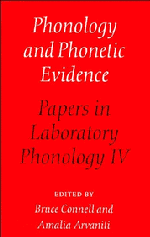Book contents
- Frontmatter
- Contents
- List of contributors
- Acknowledgments
- 1 Introduction
- I Features and Perception
- II Prosody
- III Articulatory Organization
- 15 Prosodic patterns in the coordination of vowel and consonant gestures
- 16 “Where” is timing? Comments on Smith
- 17 Asymmetrical prosodic effects on the laryngeal gesture in Korean
- 18 On a gestural account of lenis stop voicing in Korean: comments on Jun
- 19 A production and perceptual account of palatalization
- 20 An acoustic and electropalatographic study of lexical and postlexical palatalization in American English
- 21 What do we do when phonology is powerful enough to imitate phonetics? Comments on Zsiga
- 22 The influence of syntactic structure on [s] to [∫] assimilation
- 23 Assimilation as gestural overlap: comments on Hoist and Nolan
- 24 Orals, gutturals, and the jaw
- 25 The role of the jaw — active or passive? Comments on Lee
- 26 The phonetics and phonology of glottalized consonants in Lendu
- 27 Lendu consonants and the role of overlapping gestures in sound change: comments on Demolin
- Subject index
- Index of names
- Index of languages
23 - Assimilation as gestural overlap: comments on Hoist and Nolan
Published online by Cambridge University Press: 03 May 2011
- Frontmatter
- Contents
- List of contributors
- Acknowledgments
- 1 Introduction
- I Features and Perception
- II Prosody
- III Articulatory Organization
- 15 Prosodic patterns in the coordination of vowel and consonant gestures
- 16 “Where” is timing? Comments on Smith
- 17 Asymmetrical prosodic effects on the laryngeal gesture in Korean
- 18 On a gestural account of lenis stop voicing in Korean: comments on Jun
- 19 A production and perceptual account of palatalization
- 20 An acoustic and electropalatographic study of lexical and postlexical palatalization in American English
- 21 What do we do when phonology is powerful enough to imitate phonetics? Comments on Zsiga
- 22 The influence of syntactic structure on [s] to [∫] assimilation
- 23 Assimilation as gestural overlap: comments on Hoist and Nolan
- 24 Orals, gutturals, and the jaw
- 25 The role of the jaw — active or passive? Comments on Lee
- 26 The phonetics and phonology of glottalized consonants in Lendu
- 27 Lendu consonants and the role of overlapping gestures in sound change: comments on Demolin
- Subject index
- Index of names
- Index of languages
Summary
The Hoist & Nolan paper makes a welcome contribution to the work on assimilation. It is not, however, as definitive as one would like, given the relatively large number of subjects that were used in the study. In particular, the classification of their type D is problematic. They use acoustic durational data and spectral data, neither of which, I argue below, supports the conclusion they draw. In fact, although it is impossible to know for sure with acoustic data, the Hoist & Nolan data might be consistent with an analysis of all the types - A through D - as increasing gestural overlap.
In addition to the above point, the Hoist & Nolan paper purports to show that gestural overlap is not affected by syntactic processes. This claim is not supported either by their own data or by data from Hardcastle. That is, gestural overlap does appear to be affected by syntactic processes.
[s] to [∫] assimilation
Hoist and Nolan present us with two kinds of analyses, analyses of the spectra and of the acoustic durations of sentence pairs like [with commas added – CPB]:
Before a shop assistant restocks shelves, all old produce must be removed. Before a shop assistant restocks, shelves ought to be at least half empty.
They divide the spectra into four types, A through D, in which type A has two essentially stable patterns of acoustic energy, often separated by a silent pause, types B and C glide between a more [∫]–like and a more [∫]–like pattern, and type D has a single pattern of acoustic energy.
- Type
- Chapter
- Information
- Phonology and Phonetic EvidencePapers in Laboratory Phonology IV, pp. 334 - 342Publisher: Cambridge University PressPrint publication year: 1995
- 3
- Cited by



